 General
General  General Archive
General Archive  Top Cleveland Sports Figures, By the Numbers - #12 (And a quiz! Wow your friends!)
Top Cleveland Sports Figures, By the Numbers - #12 (And a quiz! Wow your friends!)
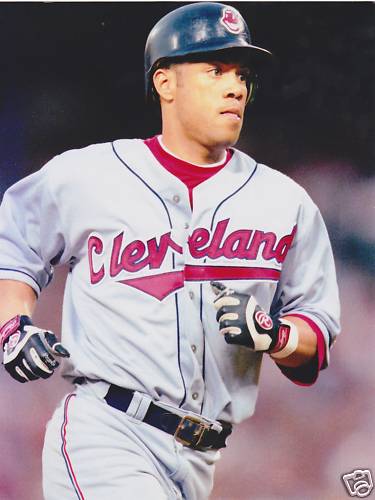 This is one installment in a team effort by The Cleveland Fan, highlighting the top local sports figures by jersey number. Please weigh in with your thoughts- click on the Boards link above. And as David Letterman would say, “For entertainment purposes only; please, no wagering.”
This is one installment in a team effort by The Cleveland Fan, highlighting the top local sports figures by jersey number. Please weigh in with your thoughts- click on the Boards link above. And as David Letterman would say, “For entertainment purposes only; please, no wagering.”
The answers to our jersey #11 quiz are below. If you care to play along, take a minute and ponder before reading on: how many Cleveland sports figures can you name who have worn jersey #12? I initially came up with a handful.
I like stories. The fabric of sports history is a compelling tapestry of recorded anecdotes. This is particularly true of baseball. I am not wired for the numbers of sports- but those who are provide interesting conclusions that they base on statistics. The stream of information of both the numbers and the stories pertaining to Cleveland sports is a big reason I have come to this site almost every day for six or seven years.
Anyway, I figure that if I can actually remember a player’s jersey number, he might be worthy of discussion. This is true of #12, corroborated by the discussion in the 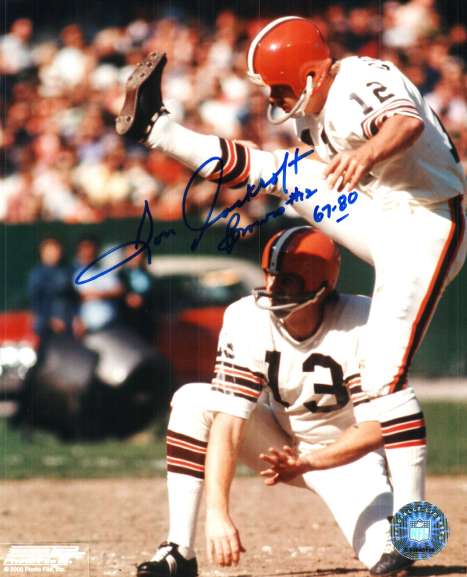 Boards on this site.
Boards on this site.
I remembered the #12 of Cleveland Browns kicker and punter Don Cockroft. One of the last of the straight-on kickers who wore the flat-toed shoe. Part of the identity of the 1970s Browns. He’s currently third in points in Browns history, behind Phil Dawson and Lou Groza (I love me some Phil, but Cockroft and Groza deserve extra appreciation, due to the poor field conditions they often faced along with the wind at the Stadium). He replaced Groza, in 1968 (when Groza became his mentor), simultaneously replacing WR Gary Collins as the punter, as well. Cockroft had that single, perfunctory facemask bar that was attached at such a low angle as to fail to serve as any kind of protection. That 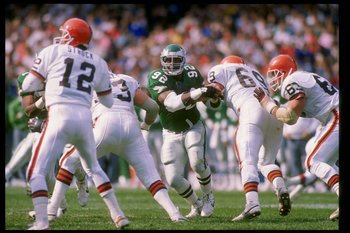 made it easy to see his ever-present mustache. Cockroft hit a 57 yard field goal in 1972, setting a Browns record. His recent book on the 1980 Kardiac Kids is a must-read.
made it easy to see his ever-present mustache. Cockroft hit a 57 yard field goal in 1972, setting a Browns record. His recent book on the 1980 Kardiac Kids is a must-read.
Don Strock wore #12 for the Browns, in the one season he played quarterback for the team. It was 1988, and Marty Schottenheimer’s team was concentrating on winning playoff games while willfully neglecting the offensive line that was assigned to protect Bernie Kosar. (That might be unfair. They also prioritized selecting first round draft busts.) Kosar was injured and put out of action twice; Gary Danielson and Mike Pagel, once each. Don Strock had retired from the Miami Dolphins, but was signed by the Browns and helped lead them to the playoffs (this was reminiscent of veteran Earl Morrall replacing an injured Bob Griese for a Miami playoff run in an earlier year). Strock performed well, leading the Browns from way back to beat the Houston Oilers in the final game of the regular season. He got knocked out of the wildcard 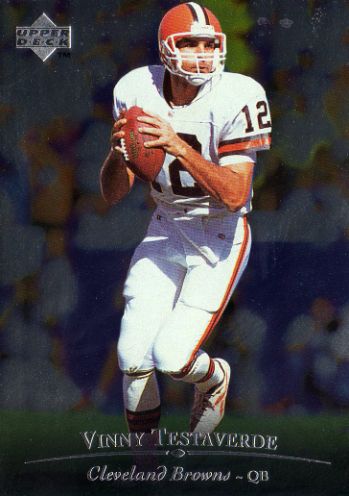 playoff game the next week, also at home vs. the Oilers. The Browns had a lead, gave it up, battled back and finally lost after trying the onside kick several times at the end (they got do-overs due to penalties). Oh well. This was the beginning of the end of that era. Kosar was banged up; Schottenheimer was fired; Earnest Byner was traded to Washington for a back who wasn’t as good.
playoff game the next week, also at home vs. the Oilers. The Browns had a lead, gave it up, battled back and finally lost after trying the onside kick several times at the end (they got do-overs due to penalties). Oh well. This was the beginning of the end of that era. Kosar was banged up; Schottenheimer was fired; Earnest Byner was traded to Washington for a back who wasn’t as good.
Vinnie Testaverde wore #12 for the Browns, as well. When the 1999 Browns drafted Tim Couch, I occasionally likened him to Testaverde a bit. They were each saddled with a horribly constructed expansion team (Vinnie’s team was Tampa Bay), and suffered through years of bad football. The losing was at least partially blamed on them (Vinnie was accused of being color blind, and was labeled “Interceptaverde”). Neither performed as poorly as later remembered, and neither was a bust.
But while Couch was driven out of football due to injury, Vinnie Testaverde had endured and actually created a mini legacy with several other teams. When head coach Bill Belichick of the Browns acquired him, and eventually replaced Kosar with him, it wasn’t his fault.
While I didn’t exactly admire Vinnie as a player, I grew fond of him to some degree. I’d attended a college game of his when he repeatedly played catch with Michael Irvin down the sideline for deep passes against an overmatched Cincinnati defense (Vinnie and Irvin were removed from the one-sided game at halftime). Part of my regard for him was from his lovable, dimwitted personality. Like the season when it was obvious Belichick had drilled him on throwing the ball away when necessary. Vinnie would chuck the ball out of bounds and throw an immediate, innocent look at his coach in a puppy-dog appeal for approval. (Maybe that’s mean- but it is honest.)
***
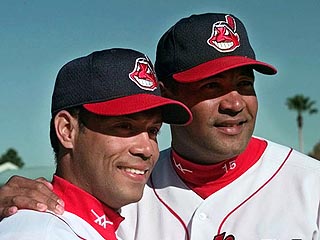 The ‘winner’ of the top #12 in Cleveland sports history seems cut-and-dry. Second baseman Roberto Alomar is in the Baseball Hall of Fame, and his seasons
The ‘winner’ of the top #12 in Cleveland sports history seems cut-and-dry. Second baseman Roberto Alomar is in the Baseball Hall of Fame, and his seasons 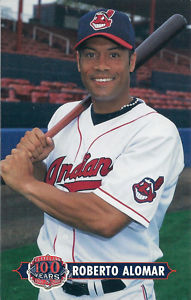 with the Tribe (and brother Sandy) were among his best.
with the Tribe (and brother Sandy) were among his best.
Indians general manager John Hart valued having a good hitter at the second base spot. It was not common, so having that was an advantage over most other teams. Carlos Baerga had been a good bat for the Tribe at second, into the 1996 season. In 1998, they acquired Robbie, and he had some great seasons at the plate. He hit .323 in 1999, and .336 in 2001. He was a consistent 20+ home run guy. The Indians were still contending for the World Series championship in those years, and Alomar finished third in the MVP voting in 1999.
Of course, his defense was off-the-charts. That alone would have ensured a long and admirable baseball career for Robbie. Actually, the Indians’ entire infield was good when he played here. In 2000, he, shortstop Omar Vizquel, and third baseman Travis Fryman each won a Gold Glove. Alomar and Vizquel 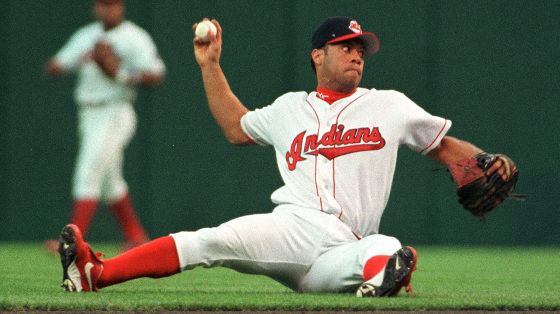 each won Gold Gloves in three consecutive seasons. And this was the BEST double play combination of my lifetime, at least. Baseball fans saw highlights of improbable, acrobatic defense from the two of them on a regular basis.
each won Gold Gloves in three consecutive seasons. And this was the BEST double play combination of my lifetime, at least. Baseball fans saw highlights of improbable, acrobatic defense from the two of them on a regular basis.
Robbie Alomar played in 17 major league seasons. He’d likely lead any list of the best #12s to play for San Diego, Toronto, and Baltimore, in addition to Cleveland. And in Las Vegas, I'm sure. Or on any list of second basemen to ever play anywhere. Or on 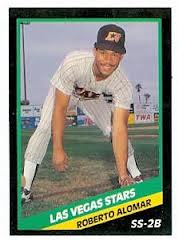 a list of players whose name begins with “A”. Or ends with “R”. Or has a last name with six letters in it. Any baseball list he’d qualify for, he’d at least be in the conversation.
a list of players whose name begins with “A”. Or ends with “R”. Or has a last name with six letters in it. Any baseball list he’d qualify for, he’d at least be in the conversation.
And he wore his pants the right way, hiked up with the socks showing, gosh darn it.
***
Here’s a brief quiz on some other #12s in Cleveland sports history.
Here are their initials, in case you want to chea- er, refer to them (“ “ denotes a nickname).
al/dm/wh/gn/dc/kh/bk/“b”c/ko/cm/ec/rg/bf
1.) This “AAAA” outfielder had a successful eighth inning drag bunt, evading the tag at first against the Reds to help the Tribe win a 2011 game. __________________________
2.) He was a soccer player from Finland who starred for the Cleveland Force in the 1980s. After one season playing in Baltimore, he returned as a Cleveland Crunch player-coach. ___________________
3.) This player is currently on the Cleveland Browns roster (at least, as of 2/9/13). ___________________
4.) He was drafted by the Cavaliers in 1997. A true, facilitating point guard, he made the all-Rookie team. Played for Cleveland until early in the 2000-01 season. ______________________
5.) He was a guy whom a bad Indians team felt had to be traded to the New York Yankees because Buddy Bell needed to play third base, and there was no room on the roster for too many promising young players. _______________________
6.) A namesake of a Beatles imitation band. Was “Glad All Over” to have played with the Indians in the late 1980s. __________________________
7.) This was an undrafted player who was acquired to be the Cavaliers’ veteran point guard in Lebron James’ rookie season. __________________________
8.) This lefty pitcher from the late 1950s is known as half of the relief tandem that was the first to popularize the use of a specialized relief ‘staff’ (as opposed to substandard ‘mop-up men’). _______________________
9.) He played for the Indians from 1958-1964. Had the proverbial ‘cup of coffee’ with six other teams. Pehaps is mostly known for being acquired by the Tribe from the Kansas City Athletics, along with Vic Power, in the trade in which they dealt away Roger Maris. ___________________
10.) He only briefly played for the Indians, in 1947. Much better known as the manager of the 1954 AL champion Tribe. When he first began calling for (#8 above) from the bullpen, tapping the arm that equated to the throwing arm of the pitcher had not yet become standard practice. This manager was known to form his hands like ears, referring to the large ears of the reliever! _____________________
11.) This point guard first played for the Heat in 1990. Bounced around the league some, playing for the Cavaliers from 2000-2003. _________________________
12.) This outfielder was dealt to the Phillies along with reigning Cy Young Award winner Cliff Lee. The Tribe recently reacquired him (they have not reacquired Cliff Lee). ________________________
13.) He replaced Roberto Alomar as the second baseman of the Indians- and also took his #12. _________________________
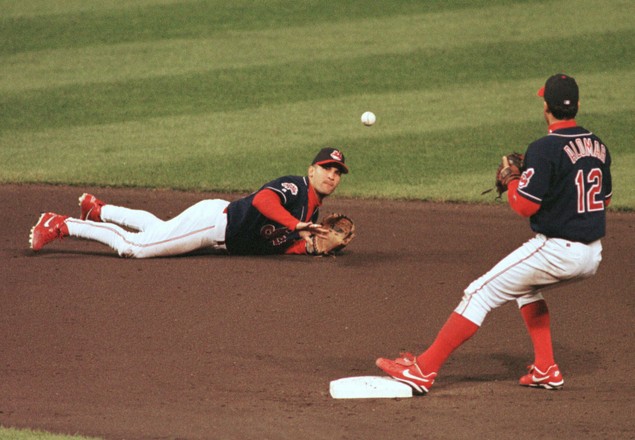
Here are the answers to the #11 quiz:
- Walt Frazier
- Art Houtteman
- Toby Harrah
- Mo Massaquoi
- Kevin Dorsey
- Kevin Johnson
- Jeff Kent
- Mark Rypien
- Tony Horton
- Damian Jackson
- Greg Swindell
- Jeff Christiansen
- Terrell Brandon
- Frank Pytlak
- Joe Adcock
- Ty Detmer
- Eddie Leon
- Matt Lawton
- Jim Ninowski
- Kevin Kouzmanoff
- Jamie Carroll
- Paul Sorrento
Thank you for reading.
- NBA Announces 2013-2014 Schedule
- Browns Ink Sharknado
- Sharknado A No-Show For Rookie Camp
- Trent Richardson Out Until Training Camp
- Browns Sign Brandon Jackson
- Carrasco Suspended Eight Games
- Browns Add to Wide Receiver Depth with David Nelson
- Browns Need to Learn from Past Draft Mistakes
- Browns Release Chris Gocong and Usama Young
- Browns Missing on Grimes Disappointing, But Not The End
The TCF Forums
- Official- Browns Coach Search/Rumors
Larvell Blanks (Tuesday, January 21 2014 11:53 AM) - The 2014 Offseason Thread
skatingtripods (Tuesday, January 21 2014 11:52 AM) - Chris Grant's first 3 drafts
Kingpin74 (Tuesday, January 21 2014 10:13 AM) - 2015 Recruiting
furls (Tuesday, January 21 2014 6:57 AM) - Mike Brown
YahooFanChicago (Monday, January 20 2014 11:15 PM) - Movies coming out
HoodooMan (Monday, January 20 2014 9:34 PM) - 2014 Hoops Hockey Hijinx
jpd1224 (Monday, January 20 2014 4:44 PM) - 2014 Recruiting
jclvd_23 (Monday, January 20 2014 2:26 PM) - Wish List - #4 Pick
Hikohadon (Monday, January 20 2014 1:26 PM) - #1 overall pick Anthony Bennett
TouchEmAllTime (Sunday, January 19 2014 1:28 PM)



